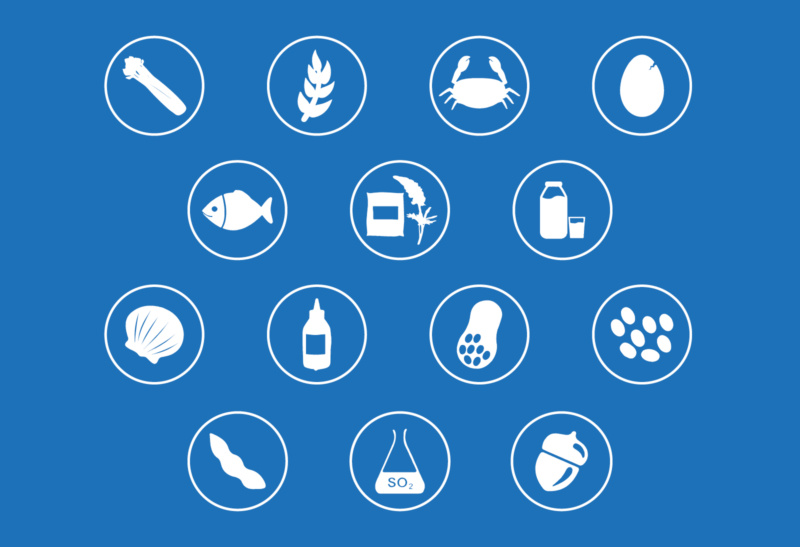This shows consumer requests for allergen information and special diets has never been more prevalent, and there is more of an expectation for venues to cater to them.
Moreover, these individuals will on most occasions be part of a group, and by not providing suitable allergen options, not only will this person choose to eat elsewhere but so will the rest of the group.
Consumers are looking for confidence that their dietary request is being taken seriously and managed appropriately, especially with the introduction of Natasha’s Law in October 2021. Venues must be able to safely cater for allergens, but this doesn’t have to be a daunting task.
This blog will go over the 3 key considerations when catering for allergens, so you can be confident when serving your customers.
1. Accommodate for dietary requirements
There are several ways to do this, like allowing for variations in a dish already on the menu – you could use a ‘build your own’ concept, or suggest swapping certain ingredients for allergen friendly ones.
Top tip: Make sure to mark things like ‘gluten free option available’ where possible, or, when using a build your own concept, mark the allergen friendly options as GF, DF etc so it is 100% clear which options can be used for each dietary requirement.
It’s important to ensure that at least one dish on your menu can meet one (or a few!) food requirements, and this doesn’t have to be boring! Why not try something exciting like gluten free Korean fried cauliflower… just make sure to use separate equipment, including the fryer.
By minimising the allergens used in the recipe, not only does this mean you can cater for that individual, it means you are making it easier for your venue and staff to manage the risk of cross contamination back of house – the fewer the number of allergens, the lower the risk.
2. Engage with your suppliers
Having a frequent line of communication with your suppliers is essential when catering for allergens. You need to be able to understand the products you are preparing, and how product information is managed along your supply chain. Talking with your suppliers is the best way to get the information you need to develop appropriate and innovative dishes for different food requirements.
For example, what if the allergen information for a product changes? There needs to be a policy in place for this, and knowledge of which products can be used as substitutes.
Not only does this make sure no unexpected allergens are in a dish, but it’s important if the data for this product is being used to create labels in line with Natasha’s Law and needs to be updated.
Information on allergens needs to be updated in a timely manner, equipping operators with correct information to label their pre-packaged foods and keep consumers safe.
3. Have clear processes to manage allergens
… And make this process start as soon as possible! When a customer walks through the door, be sure to ask if they have an allergy or intolerance, so you can cater to any additional needs straight away, i.e. a separate menu, or informing the chefs in advance.
Having regular training for staff is a must. As well as implementing a process for managing a dietary requirement order, make sure everyone from the chefs to the servers are knowledgeable and confident in allergens, and which dishes on the menu are suitable to every dietary requirement. Guesses should never be made when catering for allergens, so inform staff that if they are unsure, they should reach out to another team member or manager.
Confident staff who know their stuff means reassured customers, who can enjoy their meal without fear of having an allergic reaction.
During the preparation of the meals themselves, if possible, keep areas separate for food prep. Use separate equipment, such as chopping boards and knives, and do not place allergen free food where other allergy containing food has previously been.
It’s also important for dietary requirements to be processed appropriately to ensure the right food is being delivered. This includes how the information is sent to the kitchen, processes for serving the correct dish for the consumer, and even for it to be tracked on something like the receipt.
Top tip: label the allergen free dish with a sticker or flag when bringing it out to the customer. This reassures them that the staff have taken extra care to ensure their meal is safe to eat, and takes away the possible embarrassment of having to double check.
Clear communication, and visible understanding of the consumer’s needs (which should not to be seen as an inconvenience) are so important to their experience.
What are we doing to support our customers?
We understand how important it is to cater for allergens, so we have lots of tools to give you confidence.
We have a wide range of products available to meet special dietary requirements, including halal, kosher, vegan, vegetarian, gluten free and milk free.
Additionally, we have rigorous processes to manage ingredient and allergen information from our suppliers for products. We collect the desired dietary information from our suppliers to be able to identify if a product could be suitable for certain diets and we use this information in our reporting tools that are available through our advice centre. This information is also shared on Bidfood Direct, our online shop.
Finally, we have launched Menu Planner, also available on Bidfood Direct. This recipe analysis solution helps our customers by building recipes using Bidfood products. As part of the output, Menu Planner can summarise the allergen profile of that dish, create new allergen friendly recipes and help to generate labels that are required for Natasha’s Law.
In summary, when catering for allergens, make sure you can accommodate for dietary requirements, engage with your suppliers, and have clear processes in place. Keeping customers safe, as well as feeling reassured and understood is essential for customer experience and, in turn, generating revenue.
Find out more on how we can support you with catering for customers with allergies on our allergens page.



